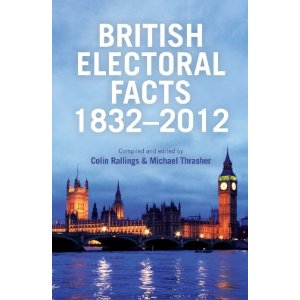British Electoral Facts 1832-2012: new edition by Colin Rallings and Michael Thrasher
 For decades, FWS Craig was the doyen of British electoral statistics. His reference works were widely used and often contained facts and figures that he had created from original sources. Yet today he is almost completely unknown.
For decades, FWS Craig was the doyen of British electoral statistics. His reference works were widely used and often contained facts and figures that he had created from original sources. Yet today he is almost completely unknown.
The reason? He died just before the internet took off. His hard work was locked away in reference volumes either sat on the shelves in libraries beyond the reach of an internet connection or available to purchase – at eye-wateringly expensive prices.
Rather like the first person to map a geographic area, even as his name has been forgotten we are all still heavily dependent on the statistical landscape he first plotted. It’s a landscape he plotted with great care and attention, as I know personally, having spent a good part of my PhD years recreating statistics from original nineteenth century sources and comparing them with his calculations.
One of FWS Craig’s most used publications was British Electoral Facts, which went through five editions. It was revived in 2000 by Colin Rallings and Michael Thrasher, who have now with Dawn Cole compiled a post-2010 election eighth edition.
The book has all the broad basic numbers you might expect, such as general election results since 1832 and numerous related numbers. One small quibble: by giving figures even from years such as 1832 to one decimal place, as in previous editions, the book implies that the numbers are more accurate than in fact is warranted given the quality of the original data. Gratuitous decimal pointing is sadly one of the statistical curses of our age.
Inevitably there is a slightly random feel to some of the statistics which are included because they happen to have been compiled – because someone happened to want them at some point in the past and therefore asked a Parliamentary question or similar.
How many people are likely to want to know the number of voluntary patients in mental hospitals in Northern Ireland in 1996 – and turn to a book on electoral facts for the answer? (Page 105 by the way.)
But then that is part of the charm of such a book, with the pleasantly curious statistic always just a few turns of the page away. I doubt I’ll come across a need to know the number of ballot papers in Scotland in 1959 spoilt for having writing or a mark by which the voter could be identified, but there are numerous other statistics which will come in useful.
An example is the table showing the number of polling stations and how they’ve been falling steadily at elections, just the sort of figures that could provide useful background to the question of whether more polling places would help election turnout.
The book has high production standards, which is particularly welcome in a reference book likely to get repeated use. This latest edition is pretty much the same as the previous one, save for the addition of the latest figures and some improvements in the typography and layout.
Buy British Electoral Facts 1832-2012 by Colin Rallings and Michael Thrasher here.
Leave a Reply